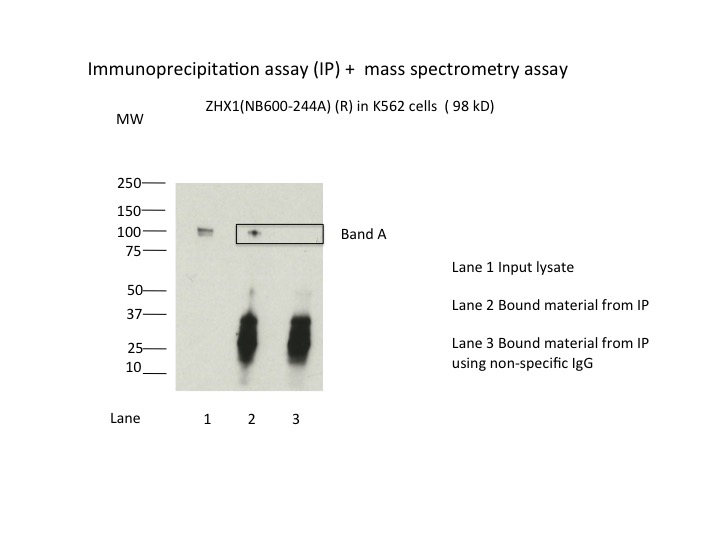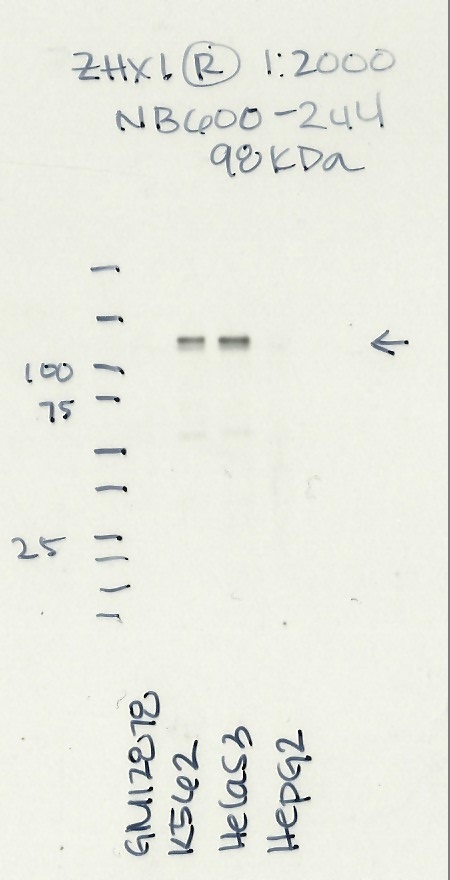ENCAB361RPF
Antibody against Homo sapiens ZHX1
Homo sapiens
K562, HeLa-S3
characterized to standards
Homo sapiens
GM12878, HepG2
not characterized to standards
- Status
- released
- Source (vendor)
- Novus
- Product ID
- NB600-244
- Lot ID
- A1
- Characterized targets
- ZHX1 (Homo sapiens)
- Host
- rabbit
- Aliases
- michael-snyder:ZHX1-human_NB600-244_A1, michael-snyder:AS-154
- External resources
Characterizations
ZHX1 (Homo sapiens)
K562
compliant
- Caption
- Immunoprecipitation was performed on nuclear extracts from the cell line K562 using the antibody NB600-244. Lane 1: input nuclear lysate. Lane 2: material immunoprecipitated with antibody. Lane 3: material immunoprecipitated using control IgG. Marked bands were excised from gel and subjected to analysis by mass spectrometry. Target molecular weight: 98.
- Submitted by
- Nathaniel Watson
- Lab
- Michael Snyder, Stanford
- Grant
- U54HG006996
ZHX1 (Homo sapiens)
GM12878K562HeLa-S3HepG2
compliant
- Caption
- Western blot analysis of nuclear lysates prepared from multiple cells lines loaded in the order: GM12878, K562, HeLaS3, HepG2 using the antibody NB600-244A. Molecular Weight: 98
- Reviewer comment
- Looks like the protein is running slightly high...
- Submitted by
- Nathaniel Watson
- Lab
- Michael Snyder, Stanford
- Grant
- U54HG006996
- Download
- ZHX1-WB-196.jpg
ZHX1 (Homo sapiens)
Method: immunoprecipitation followed by mass spectrometry
compliant
- Caption
- IP followed by mass spectrometry. Briefly, protein was immunoprecipitated from K562 nuclear cell lysates using the antibody NB600-244, and the IP fraction was loaded on a 10% polyacrylamide gel (NuPAGEBis-Tris Gel) and separated with an Invitrogen NuPAGE electrophoresis system. The gel was stained by ColloidialCoomassie G-250 stain, gel fragments corresponding to the bands indicated were excised. Then proteins were trypsinized using the in-gel digestion method. Digested proteins were analyzed on an Orbitrap Elite mass spectrometer (Thermo Scientific) by the nanoLC-ESI-MS/MS technique. Peptides were identified by the SEQUEST algorithm and filtered with a high confidence threshold (Peptide false discovery rate < 1%, 2 unique peptides per protein minimum, mass error < 10 ppm).
- Submitted by
- Nathaniel Watson
- Lab
- Michael Snyder, Stanford
- Grant
- U54HG006996
- Download
- ZHX1_NB600-244 final.pdf

